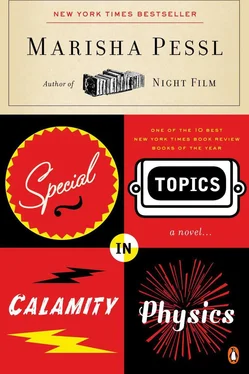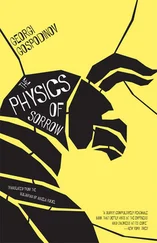On that day in 1971, a Meade, West Virginia, policeman discovered this notebook page Scotch-taped to a telephone pole ten feet from where Senator Michael McCullough’s white Cadillac Fleetwood Seventy-five had exploded in a wealthy residential community known as Marlowe Gardens. (Senator Michael McCullough climbed inside and was killed instantly in the blast.)
The Nightwatchmen’s sole manifesto could be read on www.mindfucks.net/gg (and Gracey was no Spelling Bee Winner): “Today dies a crooked and gluttonus man”—it was true, at least literally; McCullough allegedly weighed three hundred pounds and suffered from scoliosis—“a man who gets rich by the suffering of women and children, a greedy man. And so I, and the many with me, will be The Nightwatchmen, helping to divest this nation and the world of the capitalistic greed contemptuous of human life, undermining democrisy, blindfolding its people, forcing them to live in the dark.”
Dad and Herbert Littleton supplied insight into the objectives of The Nightwatchmen, inferred from the 1971 assassination, as well as Gracey’s subsequent explosion of an office building in downtown Houston on October 29, 1973. Littleton reasoned Senator McCullough had become the group’s first known assassination due to his involvement in a 1966 toxic waste scandal. Over seventy tons of toxic waste had been dumped illegally into the West Virginia Pooley River by Shohawk Industries, a textiles manufacturing plant, and by 1965, the tiny, impoverished coal mining towns of Beudde and Morrisville had suffered an increase in cancer among their low-income population. When the scandal broke, McCullough, then the governor, voiced his outrage and grief and his highly publicized, heroic mandate to clean up the river, never mind the price tag (what it cost taxpayers), had won him a seat in the senate the following election year (see “Governor McCullough Visits Five-Year-Old Boy with Leukemia,” Anatomy , Littleton, p. 193).
In truth, however, in 1989, Littleton exposed that McCullough had not only known about the dumping, and the toll it would take on the communities downstream, but he’d actually been well compensated for keeping mum, an amount estimated between $500,000 and $750,000.
The Houston bombing of 1973 illustrated, according to Dad, The Nightwatchmen’s resolve to wage war against “capitalistic greed and exploitation on a global scale.” The target was no longer a single man but the corporate headquarters of Oxico Oil & Gas (OOG). An AN/FO-based (Ammonium Nitrate/Fuel Oil) explosive was planted on the executive floor by George Gracey masquerading as a maintenance man; a security camera taped him hobbling out of the building early that morning, as well as two other figures wearing ski masks beneath janitor caps — one purportedly a woman. The blast killed three high-ranking executives, including the company’s long-time President and CEO, Carlton Ward.
Littleton contended the assault was provoked by Ward’s approval, in 1971, of a secret cost-saving initiative for Oxico’s South American oil refining interests. The proposal outlined that Oxico should stop lining their crude oil waste pits throughout refinery fields in Ecuador, allowing seepage and severe environmental contamination, yet saving $3 per barrel — an action “illustrative of the flagrant disregard for lost human life in favor of amiable profit margins.” By 1972, toxic drilling waters were actively contaminating the freshwater supply of more than thirty thousand men, women and children; and by 1989, five different indigenous cultures faced not only escalating cancer rates and severe birth defects but also total extinction (see “Girl Without Legs,” Anatomy , Littleton, p. 211).
The Houston bombing marked a sea change in tactics for The Nightwatchmen. It was then, according to Dad, that “the reality of whiny radicals ended and the legend began.” The Oxico executive assassinations disheartened (others said “defeated”) the sect; it did nothing to modify South American refinery policies — it only strengthened building security, forced the maintenance crews to suffer increasingly vigorous background checks, many losing their jobs; and an innocent secretary, a mother of four, had been killed in the explosion. Gracey was forced to go underground. The second to last confirmed sighting of him was in November 1973, a month after the Houston bombing; he was spotted in Berkeley, California, eating at a diner close to the university with an “unidentified dark-haired child, a girl between thirteen and fourteen years of age.”
If The Nightwatchmen had once been highly visible — if solely through their use of explosives — in January 1974, Gracey and the twenty to twenty-five other members resolved to carry out their goals wholly unseen, according to Dad, “without pomp and circumstance.” While most revolutionaries (even Che himself) might consider such a move unwise and self-defeating—“What is civil war if it isn’t fought in the open, deafeningly, colorfully, so the masses are encouraged to take up arms,” contends Lou Swann, Dad’s artless Harvard peer who’d penned the well-received Iron Hands (1999); “He purloined my title,” Dad noted sourly — it was actually a strategic shift Dad would deem both clever and highly sophisticated. In his various essays on insurrection, Dad maintained: “If fighters for liberty are forced to use violence, they must do it silently to be effective in the long term” (see “Cape Town Fear,” Van Meer, Federal Forum , Vol. 19, Issue 13). (This actually wasn’t Dad’s idea; he’d plagiarized it from La Grimace [Anonyme, 1824].)
For the next three or four years, The Nightwatchmen did just that; silently, they restructured, educated and recruited. “Membership tripled not only in America, but internationally,” reported a Dutch theorist who ran a Web site called “De Echte Waarheid,” “The Real Truth.” They supposedly formed a tangled web, a mysterious network with Gracey poised at the center surrounded by other “thinkers,” as they were called, and spangling the outside of this maze, countless ancillary members — the majority never meeting Gracey or even each other.
“No one knows what most members were up to,” wrote Randy on www.goodrebels.net.
I had an inkling. Charlie Quick in Prisoners of War: Why Democracy Won’t Stick in South America (1971) (a regular on Dad’s syllabus), wrote of a necessary period of “gestation,” when it was beneficial for a potential freedom fighter to do nothing but “learn everything about his enemy — including what he has for breakfast, his brand of aftershave, the number of hairs on his left big toe.” Perhaps that’s what each member had been assigned to do, collect (with the precision and patience of collecting butterfly specimens, even the rare, shy species) personal information on the men Gracey deemed their targets. Hannah had shown this level of detail when discussing the Harvey family at Hyacinth Terrace; she’d known the Civil War story about his house, Moorgate, and intimate particulars about people she’d never met, probably never even seen . Maybe Gracey was like Gordon Gekko (“You stop sending me information and you start getting me some.”) and each of the ancillary members were Bud Foxes (“He had lunch at Le Cirque with a group of well-dressed heavyset bean counters.”).
(After scribbling these speculations in my CASE NOTES, I read on.)
During this particular period, the group also abandoned the too-obvious, too-unproductive Group Meeting — in March 1974, police had come close to raiding one of their gatherings in an abandoned Braintree, Massachusetts, warehouse — in favor of more covert, well-disguised meetings, private “one on ones.” According to www.livingoffthegrid.net/gracey, these encounters typically began “at a roadside diner, truck stop or local dive bar and continued in a Holiday Inn or some other cheap motel — the intention being that the meeting would look to observers like a random pick-up, a one-night-stand,” and hence, “totally unremarkable.” (Obviously, I wanted to jump for joy when I read this, but I made myself stay focused, reading on.)
Читать дальше












